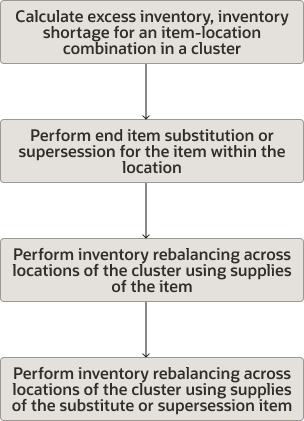How End Item Substitution and Supersession Are Done with Inventory Rebalancing
This topic provides the high-level process for how end item substitution and supersession are done along with inventory rebalancing in a replenishment plan.
The following steps explain how end item substitution and supersession are performed along with inventory rebalancing:
- The excess inventory or inventory shortage is calculated for an item-location
combination in a cluster. The substitution or supersession chains are ignored in
this step.
The logic for inventory rebalancing is used.
- End item substitution or supersession is performed within the location.
The shortage of the item in the location is resolved through the use of the excess inventory for the substitute item or supersession item at the same location.
The logic for end item substitution or supersession is used.
- The remaining inventory shortages are resolved for the item through the use of the
excess inventory for the same item in other locations in the cluster.
The logic for inventory rebalancing is used.
- Any remaining inventory shortages are resolved for the item through the use of the
excess inventory for the substitute item or supersession item in other locations in
the cluster.
The logic for inventory rebalancing is used.
The excess inventory is moved to the sweep location.
The process is summarized by the following diagram:

Additional Points to Note
Note these additional points about how end item substitution and supersession are done along with inventory rebalancing:
- In inventory rebalancing, sourcing rules aren't required for the movement of inventory between locations. This feature of inventory rebalancing is leveraged when end item substitution and supersession are done along with inventory rebalancing, and sourcing rules aren't required for the movement of substitute and supersession items in a location or between locations of a cluster.
- During end item substitution and supersession, the item relationships defined for the destination organization take precedence over the item relationships defined for the source organization.
- The inventory rebalancing window for excess inventory is considered during end item substitution and supersession. The excess window defined for end item substitution and supersession isn't considered.